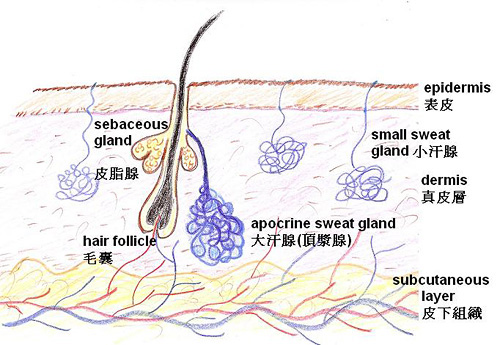|
The body sweats to cool itself, which is a way of regulating body temperature. We are born with about two to four million sweat glands in the skin, and the most numerous regions are on the palms of the hands, soles of the feet and forehead. Sweating is controlled by the nervous system and can be affected by many factors. When, where and how much people sweat varies greatly. Some people inherit a tendency to sweat heavily, especially on the palms, the soles and under the arms.
Focal excessive sweating (focal hyperhidrosis) usually peaks at 20 to 30 years of age. Excessive amounts of sweat appear equally on both sides, confined to the underarms, soles, palms, face or other specific areas. Emotional stimuli can exacerbate the situation in many cases, people complain that getting nervous triggers sweating, which then makes them more nervous and causes them to sweat even more. People are usually otherwise healthy.
Apocrine glands are large sweat glands that develop in the hair follicles and open into them. Their secretions contain proteins and fatty acids that make the sweat thicker and colored. Sweat is practically odorless, but when bacteria on the skin and hair break down the proteins and fatty acids, an unpleasant odor will be produced. That is why body odor is more intense in areas abundant in hair follicles such as underarms and the groin. People with localized sweating problems may also have an unpleasant body odor, affecting their social and working lives.
 |
| Apocrine sweat gland of the skin |
Treatment options for focal sweating vary in therapeutic efficacy, duration of effect and side effects. Generally, aluminum chloride-based topical treatments are the first choice of underarm or palm sweating. Iontophoresis (an electrical procedure) can be the second line treatment for sweating on the palms and soles. Botox injection has been approved for severe underarm sweating. Surgery should be considered as the last option when conservative therapies give no satisfactory results.
In Traditional Chinese medicine (TCM), physicians will link up the local pathologies with the affected organs or meridians, identify the disharmony pattern and formulate an appropriate therapy. Physicians use systemic as well as topical remedies to address the focal sweating problems. TCM methods can be an alternative for those who do not want to undergo more obtrusive treatment methods.
Sweating locations |
Suggested disharmonies |
Head and face |
Damp-heat steaming
Heat stagnated in the upper part of the body
Insufficient yang qi
Blood stasis |
| Underarms |
Liver deficiency and damp-heat accumulation
Heat in the heart meridian |
| Chest |
Deficiency of the heart and spleen
Yin deficiency of the heart and kidney |
| Hands and feet |
Damp-heat in the spleen and stomach
Deficiency of spleen and stomach
Yin deficiency |
Waist region |
Kidney deficiency |
| Groin region |
Damp-heat in the liver meridian
Kidney deficiency |
One side of the body (can be seen in hypertension and stroke patients) |
Deficiency of blood and qi as well as meridian blockage |
|